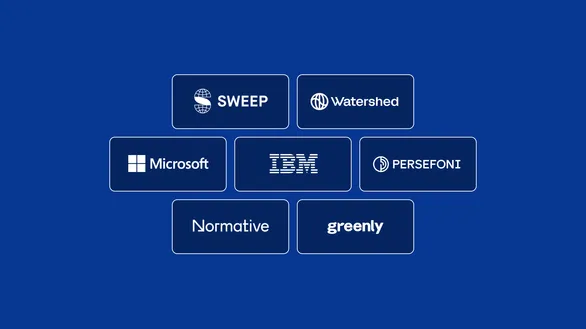A majority of top executives from large companies worldwide expect climate change to have a major impact on their business strategy over the next three years, according to a recent Deloitte survey of 2,103 business leaders. Seventy percent of respondents said rising emissions and global temperatures will have a “high or very high” impact on operations, and 45% are already changing their business model to reduce emissions and prepare for a low-carbon economy through comprehensive climate risk assessments, addressing climate risks.
Extreme weather events
These concerns are not unfounded. The economic cost of extreme weather and climate-related disasters is growing rapidly. Rising global temperatures are fueling more frequent and intense heat waves, storm surges, and forest fires, causing disruptions to industries and communities alike.
Agricultural yields are becoming increasingly unpredictable due to prolonged droughts and shifting precipitation patterns, further amplifying food security risks. Beyond financial implications, the natural world is also suffering, with ecosystems struggling to adapt to rapid environmental changes. Climate variability exacerbates risks for vulnerable populations, particularly in regions like Sub-Saharan Africa and South Asia, where changes in rainfall patterns and extreme heat pose significant threats.
In 2023 alone, natural disasters caused $380 billion in economic losses, according to Zurich Insurance Group, with less than one-third covered by insurance. As these financial risks mount due to intensifying climate change impacts, businesses, governments, and individuals must take decisive action in addressing climate risks and build long-term resilience.
What is climate risk?
Climate risk refers to the potential negative consequences of climate change on human or ecological systems, businesses, economies, and society at large. Climate change risk emphasizes the need for businesses to assess and manage the potential negative impacts of climate change on their operations and assets. These risks can be categorized into two main types: physical risks and transition risks.
Future climate scenarios play a crucial role in climate risk assessments, as scenario analysis utilizes climate science to project possible future conditions. This enables businesses to evaluate their risks and adapt their strategies for long-term sustainability and compliance with regulations.
Addressing climate risks is crucial for businesses and investors to mitigate potential financial losses and improve resilience in a changing economic landscape.
Physical climate risks
Physical climate risk describes the potential for damage and financial loss from climate change-related hazards, including extreme weather events and long-term environmental shifts. Intensifying climate hazards exacerbate these physical climate risks, leading to more severe consequences. Climate hazards, such as floods and extreme temperatures, contribute to these physical climate risks, causing significant damage to assets, economies, and communities.
These risks can significantly disrupt business operations, damage infrastructure, and affect global supply chains. The European Climate Risk Assessment (EUCRA) plays a crucial role in identifying critical climate risks affecting various sectors in Europe, such as energy, food security, and health, and emphasizes the urgent need for adaptation measures to mitigate these escalating risks.
Types of physical risks
Acute risks
Physical climate risk encompasses the potential damages and financial losses caused by sudden climate-related events, such as extreme weather events like hurricanes, floods, wildfires, and heatwaves. These acute physical risks can cause immediate damage to property, disrupt business activities, and lead to financial losses. Businesses that operate in vulnerable regions must develop contingency plans to mitigate these disruptions.
Chronic risks
Chronic physical risks result from long-term climate shifts, such as rising temperatures, rising sea levels, changing precipitation patterns, and prolonged droughts. These risks can gradually erode the viability of certain business operations, increase operational costs, and create new challenges for resource availability and supply chain stability.
Transition climate risks
Transition climate risk refers to business risks arising from the shift away from fossil fuels and greenhouse gas-emitting activities, emphasizing the implications of decarbonization. These risks are associated with changes in policies, market dynamics, reputation management, and technological advancements.
Types of transition risks
Policy risks
Governments worldwide are enacting stricter environmental regulations to combat climate change. Climate-related financial disclosures are crucial for organizations to transparently report their exposure to various climate risks and their strategies for mitigation, ensuring compliance with evolving regulations. Carbon pricing, emissions limits, and sustainability reporting requirements can increase operational costs for businesses that rely on high-carbon processes. Companies that fail to comply with evolving regulations risk penalties and reputational damage.
Market risks
Consumer preferences and investor priorities are shifting toward sustainable products and services. Companies that fail to adapt to these changing market demands may lose competitiveness. Additionally, supply chain dependencies on carbon-intensive industries could lead to financial instability.
Reputational risks
As public awareness of climate change grows, businesses face increased scrutiny regarding their environmental impact. Companies that do not take proactive sustainability measures risk reputational damage, which can lead to loss of customers, investors, and business partners.
Technology risks
The transition to a low-carbon economy is driving technological innovation. Businesses that fail to invest in sustainable technologies may become obsolete. Companies that embrace clean energy, circular economy models, and innovative carbon-reduction strategies will have a competitive advantage.
The costs of not mitigating climate change risk assessment
Rising insurance premiums: Companies in high-risk regions may face significantly higher insurance costs due to increased frequency and severity of climate-related disasters. As insurers assess risk exposure, businesses that do not take preventive measures may struggle to secure affordable coverage. Failing to address these risks can also threaten financial stability, as the economic consequences of climate-related losses and liabilities become more pronounced. Investing in renewable energy can help businesses mitigate climate risks and reduce greenhouse gas emissions.
Regulatory fines and penalties: Environmental regulations are tightening worldwide, and companies that fail to comply with new emissions standards, waste management policies, or reporting requirements can face substantial fines and legal repercussions. Repeated non-compliance can even lead to business restrictions or shutdowns.
Supply chain disruptions: Climate risks can impact transportation networks, raw material availability, and production timelines. Severe weather events can cause bottlenecks, while long-term climate changes may make certain resources scarcer and more expensive, increasing operational costs.
Loss of investor confidence: Investors are increasingly prioritizing environmental, social, and governance (ESG) factors in their decision-making. Businesses that fail to take sustainability seriously may find it harder to attract capital, leading to reduced market value and limited growth opportunities.
Decreased market competitiveness: Consumers are demanding more sustainable products and services, and businesses that fail to adapt may lose market share. Sustainability-conscious competitors could outpace traditional businesses by offering eco-friendly alternatives and appealing to changing customer expectations.
Legal liability: Climate-related lawsuits are on the rise, with companies facing litigation for failing to disclose climate risks or contributing to environmental harm. Legal battles can lead to financial losses, reputational damage, and long-term operational challenges.
Operational downtime and productivity losses: Extreme weather events can force business closures, disrupt employee commutes, and damage critical infrastructure. These disruptions translate to lost revenue, higher costs, and longer recovery times.
Supply chain realignment costs: Businesses that rely on carbon-intensive suppliers may eventually be forced to transition to greener alternatives. Making abrupt changes can be costly and challenging without prior planning and adaptation.
The role of sustainability data management in climate risk mitigation
Tracking and reporting ESG performance: Advanced sustainability data management tools help businesses monitor greenhouse gas emissions, energy consumption, and water usage. Climate change risk assessment is crucial for evaluating vulnerabilities to climate-related hazards and developing targeted strategies for resilience and adaptation. Climate risk assessments involve identifying and quantifying the potential impacts of climate change on organizations or regions, focusing on physical hazards and transition risks. These insights allow companies to meet regulatory compliance requirements, report accurately to investors, and improve sustainability performance over time.
Identifying risk hotspots: By analyzing data from different locations, companies can pinpoint climate risk vulnerabilities across their operations and supply chains. This proactive approach enables businesses to prioritize risk mitigation strategies before disruptions occur.
Optimizing resource allocation: Sustainability analytics help businesses identify inefficiencies in energy use, waste management, and water conservation. By leveraging AI-driven insights, companies can optimize processes, reduce costs, and enhance overall sustainability.
Enhancing regulatory compliance: With ever-evolving environmental laws and reporting obligations, sustainability software ensures businesses stay ahead of compliance requirements. Automated tracking minimizes human error and reduces the risk of penalties.
Improving corporate transparency: Accurate sustainability data strengthens communication with stakeholders, including investors, customers, and employees. Transparent reporting builds trust and enhances brand reputation in an increasingly eco-conscious market.
Supporting climate adaptation strategies: Businesses can use predictive analytics to model different climate scenarios and assess their potential impacts. This allows for strategic planning and early implementation of adaptation measures to safeguard long-term resilience.
Reducing operational risks: By integrating sustainability metrics into decision-making, businesses can proactively address climate-related challenges, reducing financial and reputational risks over time.
Choosing the right sustainability software platform for you
Comprehensive data integration
The ideal platform should consolidate data from various sources, including energy use, emissions tracking, water consumption, and supply chain logistics. A unified system ensures accurate monitoring and analysis. Additionally, effective climate risk management is crucial for assessing and addressing climate-related risks that organizations face.
Regulatory compliance support
Look for software that helps your business stay compliant with local, national, and international sustainability reporting standards. Built-in compliance tracking can save time and reduce errors.
Scalability and adaptability
Choose a solution that can grow with your company and adapt to new sustainability regulations and business goals. The ability to scale ensures long-term value and usability.
User-friendly interface
A well-designed platform should be easy to use, allowing employees across different departments to access and analyze sustainability data without extensive training.
Risk assessment tools
Advanced software should include scenario modeling features that help businesses understand climate risks and develop data-driven mitigation strategies.
Cost-effectiveness
Evaluate the software’s pricing model against its benefits. Some platforms may require high upfront costs but offer long-term savings by reducing inefficiencies and regulatory risks.
Customization and integration capabilities
Ensure the platform can be tailored to meet industry-specific sustainability needs and seamlessly integrate with your existing enterprise systems.
Strengthening business for a changing climate
Addressing climate risks is crucial as the growing threats posed by a changing climate demand immediate and strategic action. In high-income countries, businesses that fail to adapt to the evolving climate face greater exposure to both physical and transition risks, leading to increased socio-economic impacts. Ignoring these risks can result in economic losses, supply chain disruptions, and reputational damage. In many countries, these risks translate into long-term financial instability and knock-on effects, including higher vulnerability to forest fires and the spread of infectious diseases, particularly in regions with warmer temperatures. Climate variability exacerbates these socio-economic impacts, especially in vulnerable regions like Sub-Saharan Africa and South Asia, where changes in rainfall patterns and extreme heat threaten food security and water availability.
Conversely, businesses that integrate climate risk management into their operations can not only reduce vulnerability but also unlock new opportunities for growth, innovation, and resilience. By proactively addressing the economic impacts of climate change, decision-makers can protect their assets, enhance competitiveness, and contribute to the preservation of natural capital.
A sustainable approach to climate risk mitigation involves leveraging climate data, investing in low-carbon technologies, and strengthening climate adaptation strategies. Understanding and addressing the consequences of climate change today will determine long-term success in an increasingly uncertain future, ensuring that businesses are better prepared to weather the economic challenges posed by a warming world.




